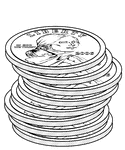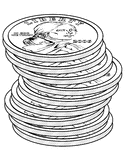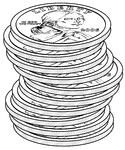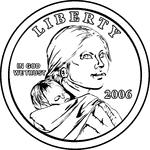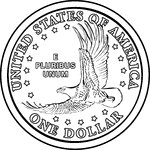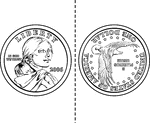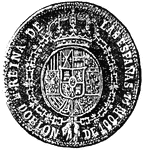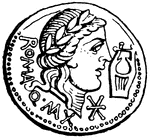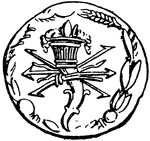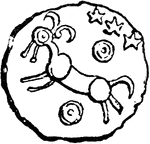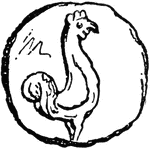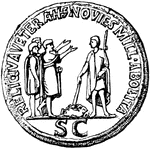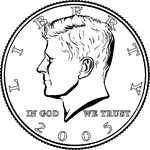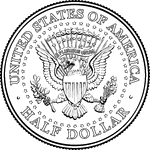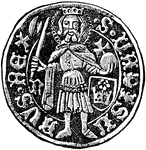
Ducat of Ladislaus Postumus, Obverse
The obverse side of a Ducat, a gold coin, of Ladislaus Postumus, the King of Hungary from A.D. 1452-1457.
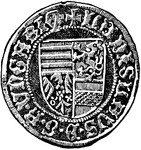
Ducat of Ladislaus Postumus, Reverse
The reverse side of a ducat, a gold coin, of Ladislaus Postumus, the King of Hungary from A.D. 1452-1457.
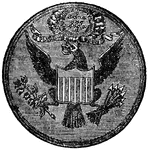
Eagle on Seal of United States
"The Eagle is a gold coin of the United States, value $10; half-eagle, $5; quarter-eagle, $2.50, double…
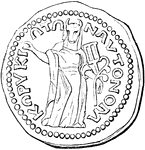
Emblem of Ash'Toreth
An image of Ash'Toreth, or Ash'Taroth, who was called Astarte by the greeks. She was commonly known…
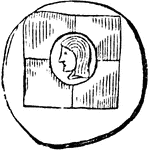
Encased Coin
"The surrounding of the punchmark with a band bearing a name, and the introduction of a head in its…

English Coin
"The pennies of the Saxon and Danish sole monarches of England had a portrait on them. Alfred's earlier…
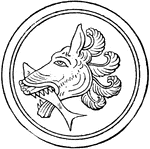
Episemon
Episema were used in Greece as a symbol for a country, region, or used on a shield or badge. This episemon…

Obverse and Reverse Sides of Farthing of Charles II
The obverse and reverse sides of the farthing depicting Charles II. The farthing was an English coin…

Fourpenny Piece of Queen Victoria
The obverse and reverse sides of the fourpenny piece, or groat, an English silver coin worth fourpence.
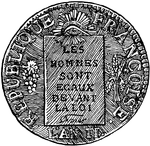
French Sou from 1793, Obverse
"Under Louis XV, and Louis XVI, the sou was struck in copper, and had an intrinsic value of two deniers…
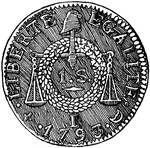
French Sou from 1793, Reverse
"Under Louis XV, and Louis XVI, the sou was struck in copper, and had an intrinsic value of two deniers…

Obverse and Reverse Sides of a Gazzetta
"Gazzetta of the Ionian islands, 1801. A small copper coin, worth about 3 farthings, made in Venice…

Obverse Side of George-Noble
"Obverse. George-noble of Henry VIII. GEORGE-NOBLE. An English gold coin of the reign of Henry VIII.,…
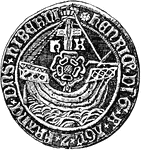
Reverse Side of George-Noble
"Reverse. George-noble of Henry VIII. GEORGE-NOBLE. An English gold coin of the reign of Henry VIII.,…

Gorkha Coin
"Gorkha deoasea coinage; rubbing from coin in British Museum." —The Encyclopedia Britannica, 1910

Greek Coin
"In the reign of Philip of Macedon, the coinage of Greece had attained its full development, having…
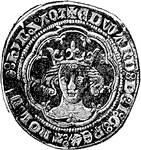
Obverse Side of Groat of Edward III
"Obverse. Groat of Edward III. GROAT. An English silver coin, of the value of fourpence, first issued…

Reverse Side of Groat of Edward III
"Reverse. Groat of Edward III. GROAT. An English silver coin, of the value of fourpence, first issued…
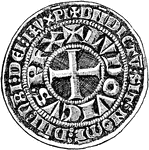
Obverse Side of Gros Tornois
"Gros Tournois of Louis IX. GROS. A coin of relatively large size: applied to silver coins of various…

Reverse Side of Gros Tornois
"Gros Tournois of Louis IX. GROS. A coin of relatively large size: applied to silver coins of various…

Groschen
"Groschen of Hanover, 1866. GROSCHEN. A small silver coin of various kinds in Germany from the fourteenth…

Guinea
"Guinea of Charles II., 1663. GUINEA. An English gold coin, of the value of 21 shillings, first issued…
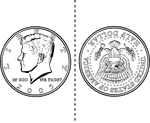
Two Sided Half Dollar
An illustration of both sides of a U.S. Half Dollar that can be cutout and folded.
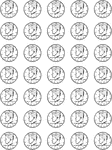
Array of Half Dollars
An array of multiple illustrations of the portrait side of a U.S. Half Dollar.
